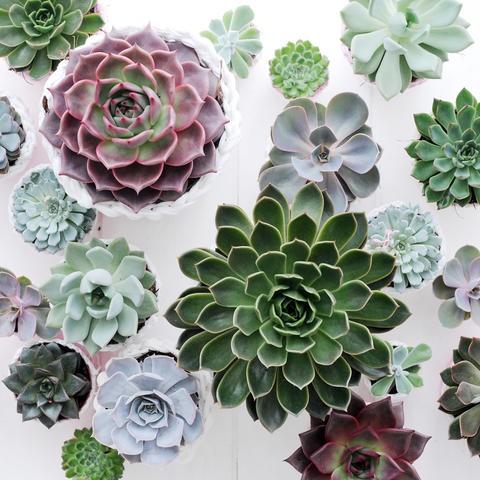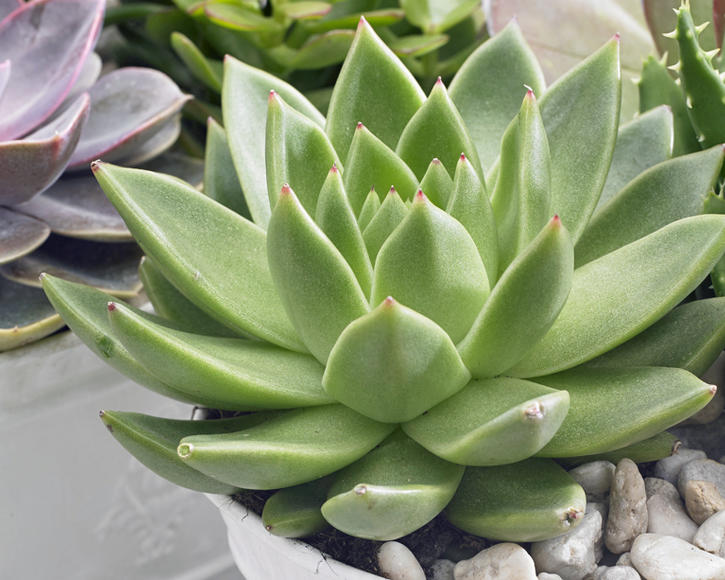Echeveria
The decorative Echeveria is robust and hardly needs any water—the ideal houseplant for those who cannot spend a lot of time on care.
Factsheet
- Growth type
-
- Perennial plant
- Succulent
- Growth height (from)
- from 10 cm to 15 cm
- Growth width (from)
- from 7 cm to 15 cm
- Growth characteristics
-
- rosette-forming
- foothills
- Flower color
-
- yellow
- orange
- red
- pink
- Flowering time (month)
-
- March to June
- Flower shape
-
- Uniflorous
- Flower characteristics
-
- unfilled
- hermaphroditic
- Leaf color
-
- green
- page format
-
- triangular
- Sheet properties
-
- wintergreen
- Rosette
- Light
-
- sunny
- Soil type
-
- gravelly to sandy
- Soil Moisture
-
- moderately dry to fresh
- ph value
-
- weakly alkaline to weakly acidic
- Lime compatibility
-
- lime-tolerant
- Nutrient requirements
-
- moderately nutritious
- Humus
-
- low humus
- Decorative or utility value
-
- Flower Decoration
- Leaf ornaments
- Toxicity
-
- weakly poisonous
- Winter Hardness
-
- frost-sensitive
- Climate zones according to USDA
-
- 12
- Use
-
- Interior greening
- Planters
- Winter garden
- Warm House
- Garden style
-
- Pot garden
The succulent Echeveria (Echeveria agavoides) belongs to the stonecrop family (Crassulaceae). It is native to the rocky arid regions of Mexico. But you can also find them in Texas and Peru. The various types differ in shape, size, appearance and color. Some have fine hairy leaves, others are covered with a layer of wax. Both variants protect the plant from direct sunlight. Mostly hybrids and cultivated varieties are available commercially. In addition (unfortunately) also specimens with artificially colored leaves in black or pink are also available.
The popular and extremely easy-care houseplant has very beautiful leaves that are arranged in a pretty rosette - and hardly needs watering. This makes the Echeverie the ideal plant decoration for workaholics and people who travel a lot, either professionally or privately. You can also use them to liven up the surroundings: In a lively succulent picture, Echeveria, for example, looks striking.
The Echeveria is about 3.93 to 5.90 inches high and at least as wide. It has a highly compressed stem axis. This is not visible from the outside, but densely covered with rosette-like leaves. As a rule, the pots gradually fill with daughter rosettes until the soil is completely covered.

The leaf rosette of the Echeveria has a diameter of 2.75 to 5.90 inches. Typically, about 20 leaves are formed, which are triangular in shape and converge to a point at the front. The leaf margins are sometimes reddish in color; the leaves themselves are green and thick-fleshed. This allows it to store water perfectly and survive every vacation without having to request your neighbors to water your plants. Two to three weeks of drought are usually not a problem.
The inflorescence are shaped as wraps, similar to tomatoes or forget-me-nots. The flower stalk itself can be up to three centimeters long and towers above the leaves. The flowers are bell-shaped and hanging. The color ranges from pink to yellowish orange-red. They appear from around March to June. The elegant leaf rosette is the most striking feature of the echeveria.

Give Echeveria a very bright to sunny spot all year round; in summer you can also put them in a covered, warm place outside. Make sure rain doesn’t get to this spot. In winter it likes to be a little cooler with temperatures of a maximum of 59 degrees Fahrenheit, but must never be exposed to frost.
The Mexican demands moderately nutrient-rich, but well-drained mineral soil with a pH value of 5.5 to 7. You can use commercially available cactus substrate for them.
The pretty houseplant needs very little water, in winter almost none at all. Do not pour it on the leaf rosette, just pour around the surrounding substrate. Otherwise mold or rot will quickly develop in the leaf axils. Wait until the soil is completely dry before watering again.
Tip: You will realize you've watered your echeveria too much when its leaves start to lose color and fade. The plant quickly adjusts to the reduced water supply.
In the summer or from April to September you can fertilize once a month. To do this, use cactus fertilizer. As a rule, freshly repotted plants do not need any fertilizers at first.
The Echeveria only needs to repot about every two years if the pot is too small or the substrate is consumed. It is best to do this in the period from spring to early summer. The plant should not be placed too deep in the substrate.
Caution: Echeveria are mildly poisonous and skin contact with broken leaves can cause irritation in rare cases.

The Echeveria does not need pruning in the true sense of the word. Wilted or dried up parts can and should be removed. Do not use scissors or a knife for this, but simply pull out the relevant parts with a sharp tug. This way, no residues remain on the plant that could possibly start to rot.
The Echeveria is propagated by side rosettes, leaf cuttings or sowing. Simply pluck a leaf from the rosette and pat dry the resulting wound with a cloth. Then you can put the cutting directly in a peat-sand mixture. The optimal rooting temperature is 64.4 to 68 degrees Fahrenheit. You can also quickly grow new plants from side rosettes. It is not possible to sow all varieties, as some do not produce fertile seeds. If available, they germinate very well at 64.4 degrees Fahrenheit.
If the plant is watered correctly, the risk of leaf or root rot is virtually eliminated. Occasionally, aphids appear on the flowers. Check regularly for any infestation. Otherwise, the Echeveria has proven to be quite resistant to disease and pests.

